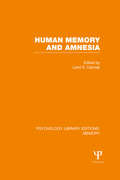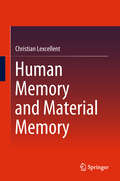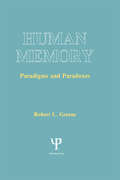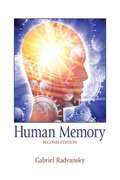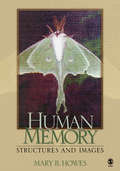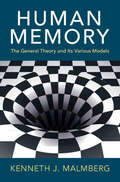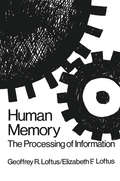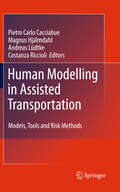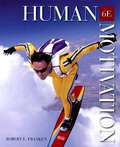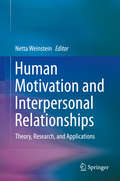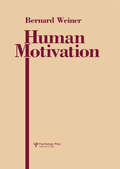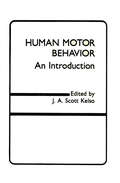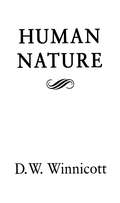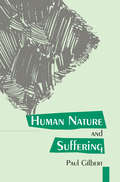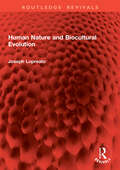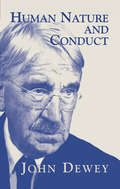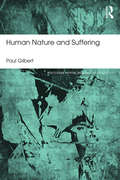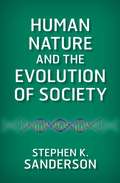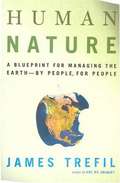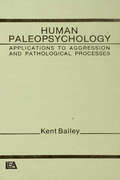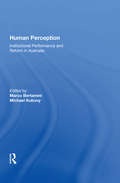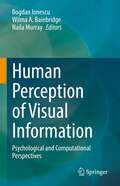- Table View
- List View
Human Memory
by Gabriel A. RadvanskyHuman Memory, 4th edition, provides a comprehensive overview of research and theory on human memory. Written in an engaging style, the book is divided into three sections, providing an accessible introduction to the application and assessment of memory theory. Beginning with the history of memory, the first section explores basic methodology and neuroscience. The second section examines the key topics of memory such as the sensory registers, mechanisms of forgetting and short-term, nondeclarative, episodic, and semantic memory. The third section focuses on specialist topics such as amnesia, memory for space and time, autobiographical memory, memory and reality, memory and the law, metamemory and formal models of memory. Instructors could pick and chose which of these chapters best fit the goals of their course. New to this edition: More prominent discussion of neuroscience findings. Coverage of a wider range of neuroscientific techniques. Greater emphasis on memory changes over time. New explanation of how to calculate a wider range of signal detection measures. Additional content on a wide range of topics including the mirror effect, sleep-related memory processes, vicarious autobiographical memories, inter-generational memory transmission, the impact of lying on memory, eyewitness collaboration, and aging and spatial memory. Expanded coverage of areas including theories of hypermnesia, chunking, serial order memory, prospective memory, threshold models, and eyewitness line-up identification. Updated companion resources, including PowerPoint slides and exam questions. The book highlights the application of memory theory and findings to everyday experience, presents in-depth explorations of studies, and provides opportunities for students to explore the assessment of memory in more laboratory-based settings. Packed full of student-friendly pedagogy including study questions, Stop and Review and Try it Out sections, Study in Depth text boxes, and more, Human Memory, 4th edition is an essential companion for all students of human memory.
Human Memory and Amnesia (Psychology Library Editions: Memory)
by Laird S. CermakOriginally published in 1982, this book brings together two areas of research previously studied in parallel, with little interaction (particularly in the US): normal memory processing and the amnesic syndrome. When trying to document the relationship between the two it became apparent that there was much crossover and duplication of effort in a number of areas: whether long-term memory and short-term memory truly represent independent storage systems, or are simply points on a continuum; trying to determine the primary locus of variables influencing the rate at which information is lost during retention; whether episodic memory and semantic memory represent two different storage systems, or are simply artifacts produced by different kinds of query to a single memory system and finally, whether visual and verbal memory are independent. It was written, following a meeting in 1979, by a small group of investigators, brought together to explore this commonality and to share data and theory, thus beginning the promise of a bright future of interdisciplinary interaction in memory research.
Human Memory and Material Memory
by Christian LexcellentThis book investigates the fascinating concept of a continuum between human memory and memory of materials. The first part provides state-of-the-art information on shape memory alloys and outlines a brief history of memory from the ancient Greeks to the present day, describing phenomenological, philosophical, and technical approaches such as neuroscience. Then, using a wealth of anecdotes, data from academic literature, and original research, this short book discusses the concepts of post-memory, memristors and forgiveness, highlights the analogies between materials defects and memory traces in the human brain. Lastly, it tackles questions of how human memory and memory of materials work together and interact. With insights from materials mechanics, neuroscience and philosophy, it enables readers to understand and continue this open debate on human memory.
Human Memory: Paradigms and Paradoxes
by Robert L. GreeneThe fact that cognitive psychology has become largely concerned with a handful of laboratory tasks has brought expressions of concern and suggestions about how to place the field on a more solid footing. The view expressed here, however, is that the classic cognitive paradigms have become fascinating puzzles on which some of the best minds in the field have labored. An examination of the development of research in these areas yields many examples of the scientific method at its most sophisticated, as well as impressive examples of how theories and data can interact. Covering the whole temporal range of memory experiences, this volume provides a review of the major paradigms that have been used by experimental psychologists to study human memory.
Human Memory: Second Edition
by Gabriel A. RadvanskyProvides students with a guide to human memory, its properties, theories about how it works, and how studying it can help us understand who we are and why we do the things that we do. For undergraduate and graduate courses in Human Memory. This book provides a very broad range of topics covering more territory than most books. In addition to some coverage of basic issues of human memory and cognition that are of interest to researchers in the field, the chapters also cover issues that will be relevant to students with a range of interests including those students interested in clinical, social, and developmental psychology, as well as those planning on going on to medical and law schools. The writing is aimed at talking directly to students (as opposed to talking down to them) in a clear and effective manner. Not too dense, but also not too conversational as well. This 2nd edition includes a series of exercises that allow the student to try out the concepts and principles conveyed in the chapters, or to use as the basis for exploring their own ideas.
Human Memory: Structures and Images
by Mary B. HowesHuman Memory: Structures and Images offers students a comprehensive overview of research in human memory. Providing a theoretical background for the research, author Mary B. Howes uses a clear and accessible format to cover three major areas—mainstream experimental research; naturalistic research; and work in the domains of the amnesias, malfunctions of memory, and neuroscience.
Human Memory: The General Theory and Its Various Models
by Kenneth J. MalmbergThe General Theory of human memory is the most prominent result of the cognitive revolution in psychology. Despite its role in modern memory research, the General Theory is not well understood. This book describes the General Theory of human memory and applies it to numerous empirical phenomena. It details the prominent architectures for formally modeling the flow of information among the proposed memory structures using the search of associative memory (SAM) and the retrieving effectively from memory (REM) models.
Human Memory: The Processing of Information
by Elizabeth F. Loftus Geoffrey R. LoftusOver the past 20 years, the study of human memory has become an increasingly popular topic of study for psychologists, and since the late 1960s a new framework for studying memory has begun to take shape. It is the purpose of this book to present a broad overview of this framework, including descriptions of (1) the major theoretical components of the framework and (2) the critical research findings that justify the establishment of these components and illuminate the mechanisms by which they operate. The book is not meant to constitute an exhaustive review of the enormous research literature that has accrued over the years. The authors deliberately avoid wading into masses of detail on any given topic area, and we deliberately sidestep a number of current theoretical controversies. Instead, this book has been planned to be a guide and an introduction for the student or interested layman with little or no background in the area of memory as a field of psychological inquiry.
Human Microbiome in Health, Disease, and Therapy
by Pallaval Veera BramhachariThis book illustrates the role of the human microbiome in health and diseases. It discusses the association of an imbalanced human microbiome with different human diseases, including inflammatory, metabolic conditions, neurological, cardiovascular, and respiratory diseases. The book further reviews the association between intestinal microbiota and immune defense systems. The book provides evolving knowledge of the development, complexity, and functionality of the healthy gut microbiota and covers interventions that modulate and stabilize the gut microbiota. Further, it introduces the human microbiome as a reservoir of AMR genes, the current knowledge on the resistome, and the recent and upcoming advances in molecular diagnostic approaches to unravel this reservoir. Toward the end, the book reviews the advances in understanding the human urinary microbiome and its potential role in urinary tract infection. The chapter also presents the dynamics of the skin microbiome and the association of microbiota with skin disorders and therapeutic interventions. This book is an invaluable read for health professionals, medical students, microbiologists, and scientific research communities who are eager to update themselves with recent trends in microbiome research.
Human Modelling in Assisted Transportation
by Carlo Cacciabue Magnus Hjälmdahl Costanza Riccioli Andreas LuedtkeThe objective of this Workshop is to confront models, methods and tools developed within the projects with the ongoing research worldwide and to provide an environment for fruitful exchange of ideas. The main topics are: 1. Advanced human models in transportation. 2. Human Errors and Risk Assessment in design processes of assistance systems. 3. Methods and tools to prevent erroneous behaviour to mitigate its consequences. The Workshop will consist of 10 keynote lectures as well as approximately 28 peer reviewed papers.
Human Motivation (Sixth Edition)
by Robert E. FrankenThis Sixth Edition provides a thorough introduction to the basic facts and major theories of human motivation. Throughout the book, the author addresses the types of questions that often arise, such as "Why are some people more organized than others?" and "Why do people dream?" In his exploration of day-to-day human motivation, Franken provides a topical organization that shows students how biology, learning, and cognition interact with individual differences to produce human behavior.
Human Motivation and Interpersonal Relationships
by Netta WeinsteinThis volume summarizes and organizes a growing body of research supporting the role of motivation in adaptive and rewarding interpersonal interactions with others. The field of human motivation is rapidly growing but most studies have focused on the effects of motivation on individuals' personal happiness and task engagement. Only recently have theorists and empiricists begun to recognize that dispositional and state motivations impact the ways individuals approach interpersonal interactions. In addition, researchers are now recognizing that the quality of interpersonal interactions influences consequent happiness and task engagement, thus helping to explain previous findings to this end. Similarly social psychology and relationships researchers have focused on the impact of cognitions, emotions, and behaviors on people's relationships. In their work, relationships researchers demonstrate that both contextual characteristics and individual differences influence the quality of interactions. Many of these studies seek to understand which characteristics strengthen the bonds between people, encourage empathy and trust and create a sense of well-being after a close interaction. This work seeks to integrate the field of human motivation and interpersonal relationships. Both fields have seen extensive growth in the past decade and each can contribute to the other. However, no single compiled work is available that targets both fields. This is the case, in part because only now is there enough work to make a strong and compelling case for their integration. In the previous years, research has been conducted to show that motivation is relevant and important for interactions among strangers and in close relationships. In addition developmental mechanisms for these relations are identified and mechanisms by which motivation strengthens people's relationships. Finally recent work has demonstrated the many implications for interpersonal relationships, showing that motivation impacts a range of interpersonal processes from prejudice regulation and objectification of others to empathy and care. This book seeks to summarize and organize all these findings and present them in a way that is relevant to both motivation researchers and social and relationship researchers.
Human Motivation: Metaphors, Theories, And Research
by Bernard WeinerWeiner introduces -- and offers his own motivation for producing - - this most impressive work with the following: There are two distinct approaches to the study of motivation. One stratagem is a product of academic, experimental procedures, while the second is an outgrowth of clinical, non-experimental methods. Each of the approaches has unique advantages and disadvantages. But all investigators in this field are guided by a single basic question, namely, "Why do organisms think and behave as they do?" To help answer that basic question, Human Motivation presents an entire range of motivation studies -- from psychoanalytic, social learning and humanistic theory; to social facilitation, arousal, emotions, personal responsibility, and the irrationality of attributions; through chapterand verse of Hullian and Lewinian theory.
Human Motor Behavior: An Introduction
by J.A. Scott KelsoWhy should anyone be interested in studying motor skills? This book is based on the contrary belief that the determinants of motor skill and the conjoint problems of how movements are coordinated and controlled are fundamentally important to anyone concerned with understanding human behavior. This includes psychologists, but applies even more especially to other disciplines-such as physical education and kinesiology-for which the subject of movement is particularly germane. In fact, this book is written primarily for undergraduates in kinesiology and physical education as well as psychology, and it may also be of interest to students in areas such as physical therapy, engineering and computer science.
Human Nature
by D. W. WinnicottFirst published in 1990. Routledge is an imprint of Taylor & Francis, an informa company.
Human Nature And Conduct
by John Dewey John CappsIn Human Nature and Conduct, the philosopher John Dewey looks at the connection between human nature and morality. While some people believe that we are naturally good, others believe that we are naturally evil. Likewise, while some people believe that morality is all relative, others believe that moral laws are as universal as laws of nature. In these twenty-six succinct chapters Dewey argues that morality is not so simple. He claims that morality depends on both individual people and societies, on both nature and nurture, and on a complex interaction between biological impulses, social customs, and human intelligence. He argues against those who believe morality depends on the will of the majority, those who believe it depends on the will of God and, most of all, those who believe the purpose of morality is to protect us from our own instincts. In Human Nature and Conduct Dewey gives us a new perspective on morality.
Human Nature And Suffering (Routledge Mental Health Classic Editions Ser.)
by Paul GilbertThis volume explores the implications of humans as evolved social animals. Gilbert suggests that evolution has given rise to a varied set of social competencies which form the basis of our personal knowledge and understanding. These competencies are classified as: a) Care eliciting b) Care giving c) Co?operating and d) Competing. Each of these are seen as core schemata, or archetypal potentials around which knowledge is built, and from which, our propensity for suffering flow. For example our predisposition to think of ourselves as superior or inferior to others comes from innate competencies which evolve from dominance and social ranking. Gilbert shows how primitive competencies become modified by experience and what happens when this modification is unsatisfactory, for example leading to preoccupations with fantasy and behaviour which is dominance and power focused. Throughout the text Gilbert shows how two psychological systems (derived from ethological and experimental work), labelled the defense and safety system dominate the unfolding and integration of human mental life. In the last chapter these varied themes are brought together to indicate how the social construction of self arises from the organization of knowledge encoded within the four competencies. Gilbert highlights how cultural factors may modify and activate many of our more primitive competencies leading not only to pathology proneness but also to behaviours that are collectively survival threatening.
Human Nature and Biocultural Evolution (Routledge Revivals)
by Joseph LopreatoFirst published in 1984, Human Nature and Biocultural Evolution aims to delineate a theory of human nature, viewed as an interrelated set of genetically programmed behavioral predispositions, and a theory of biocultural evolution. The author’s approach is based on the hypothesis that innate predispositions and cultural-environmental factors cooperate to determine human behavior and socio-cultural forms.Professor Lopreato begins by tracing the development of evolutionary biology up to sociobiology. It is his argument that the social and biological disciplines have, for over a century, been moving towards a synthesis, and that Homo sapiens is neither just another animal, nor so unique a being that culture has become divorced from its genetic underpinnings. The argument is supported with evidence from evolutionary biology and social science, with a critical discussion of basic issues of behavioral science and with an analysis of certain famous theories in social science (e.g. theories of suicide, anomie, capitalism), which prove to be richer and more complete when viewed from a biocultural perspective.The theory of human nature is arrived at through a rich analysis of ethnographic, psychological, and sociological arguments and data, as well as facts and theories from comparative zoology. In the process, the author treats critically numerous theoretical problems associated with topics such as exploitation, class consciousness, structured inequality, reciprocal behavior, territorial aggression, religious ritual, socialization, ethnicity, and prejudice. The author concludes with an examination of behavioral predispositions that are hypothesized to be at the base of cultural variation.
Human Nature and Conduct
by John DeweyA morality "based on the study of human nature instead of upon disregard for it" is the focus of this influential work by one of America's greatest educators and philosophers. John Dewey maintains that the key to social psychology lies in an understanding of the many varieties of habit; individual mental activity, on the other hand, is guided by the subordinate factors of impulse and intelligence."The mind," Dewey asserts, "can be understood in the concrete only as a system of beliefs, desires, and purposes which are formed in the interaction of biological aptitudes with a social environment." His investigation focuses on three main areas: the place of habit in conduct; the place of impulse in conduct; and the place of intelligence in conduct. Each factor receives an incisive treatment, brimming with ideas, insights, and considered reflections.This classic of its genre presents a rich banquet of food for thought, certain to be appreciated by educators, psychologists, philosophers, and anyone interested in the role of the individual in society.
Human Nature and Suffering (Routledge Mental Health Classic Editions)
by Paul GilbertHuman Nature and Suffering is a profound comment on the human condition, from the perspective of evolutionary psychology. Paul Gilbert explores the implications of humans as evolved social animals, suggesting that evolution has given rise to a varied set of social competencies, which form the basis of our personal knowledge and understanding. Gilbert shows how our primitive competencies become modified by experience - both satisfactorily and unsatisfactorily. He highlights how cultural factors may modify and activate many of these primitive competencies, leading to pathology proneness and behaviours that are collectively survival threatening. These varied themes are brought together to indicate how the social construction of self arises from the organization of knowledge encoded within the competencies. This Classic Edition features a new introduction from the author, bringing Gilbert's early work to a new audience. The book will be of interest to clinicians, researchers and historians in the field of psychology.
Human Nature and the Evolution of Society
by Stephen K. SandersonIf evolution has changed humans physically, has it also affected human behavior? Drawing on evolutionary psychology, sociobiology, and human behavioral ecology, Human Nature and the Evolution of Society explores the evolutionary dynamics underlying social life. In this introduction to human behavior and the organization of social life, Stephen K. Sanderson discusses traditional subjects like mating behavior, kinship, parenthood, status-seeking, and violence, as well as important topics seldom included in books of this type, especially gender, economies, politics, foodways, race and ethnicity, and the arts. Examples and research on a wide range of human societies, both industrial and nonindustrial, are integrated throughout. With chapter summaries of key points, thoughtful discussion questions, and important terms defined within the text, the result is a broad-ranging and comprehensive consideration of human society, thoroughly grounded in an evolutionary perspective.
Human Nature: A Blueprint for Managing the Earth-By People, for People
by James S. TrefilTrefil, a leading scientist, is certainly qualified to tackle the controversial, timely topic of how humans ought to affect the planet they live on. He argues that from the dawn of an agricultural society, man has always engineered nature to suit his needs. And because we're the only form of life with the ability to move mountains (as much literally as metaphorically), there's no rational reason not to manage the environment
Human Paleopsychology: Applications To Aggression and Patholoqical Processes
by K. BaileyFirst Published in 1986. In this book the author seeks to demonstrate his believe that any credible view must grapple not only with human distinctiveness (e.g., learning capacity, language, rationality, and culture), but the dark sides of senseless violence and social disorder as well. Any such grappling with the dark side must necessarily confront our animal natures as well as our distinctly human natures.
Human Perception
by Marco Bertamini Michael KubovyIt takes little or no effort for us to gather information by means of our senses but it would be a mistake to take this as a sign that perception is simple. It was in the 20th century and after the establishment of psychology as a scientific discipline that the study of perception flourished. This important volume gathers together a selection of articles and essays which represent some of the most interesting discoveries and theories. It gives a flavour of the many different approaches and ideas taken by cognitive psychologists in this fascinating area. Topics covered include: attention, brain systems, object interpolation and completion, object recognition and classification, different types of objects, and information processing and models.
Human Perception of Visual Information: Psychological and Computational Perspectives
by Bogdan Ionescu Wilma A. Bainbridge Naila MurrayRecent years have witnessed important advancements in our understanding of the psychological underpinnings of subjective properties of visual information, such as aesthetics, memorability, or induced emotions. Concurrently, computational models of objective visual properties such as semantic labelling and geometric relationships have made significant breakthroughs using the latest achievements in machine learning and large-scale data collection. There has also been limited but important work exploiting these breakthroughs to improve computational modelling of subjective visual properties. The time is ripe to explore how advances in both of these fields of study can be mutually enriching and lead to further progress.This book combines perspectives from psychology and machine learning to showcase a new, unified understanding of how images and videos influence high-level visual perception - particularly interestingness, affective values and emotions, aesthetic values, memorability, novelty, complexity, visual composition and stylistic attributes, and creativity. These human-based metrics are interesting for a very broad range of current applications, ranging from content retrieval and search, storytelling, to targeted advertising, education and learning, and content filtering.Work already exists in the literature that studies the psychological aspects of these notions or investigates potential correlations between two or more of these human concepts. Attempts at building computational models capable of predicting such notions can also be found, using state-of-the-art machine learning techniques. Nevertheless their performance proves that there is still room for improvement, as the tasks are by nature highly challenging and multifaceted, requiring thought on both the psychological implications of the human concepts, as well as their translation to machines.

